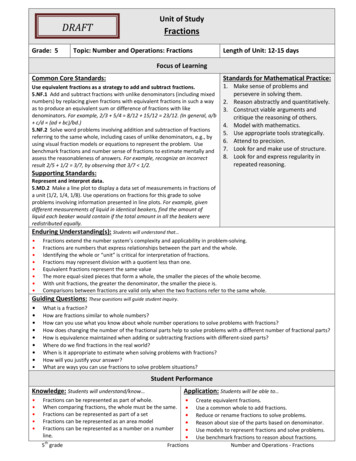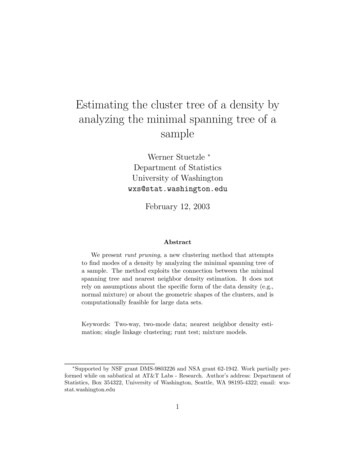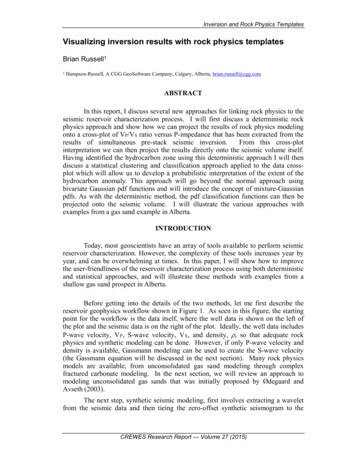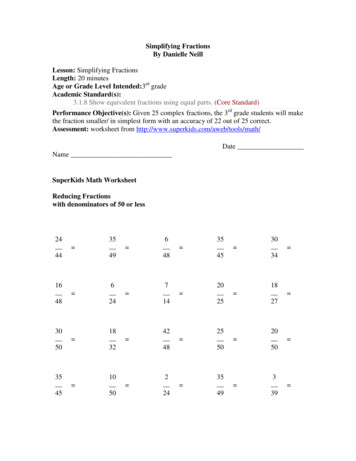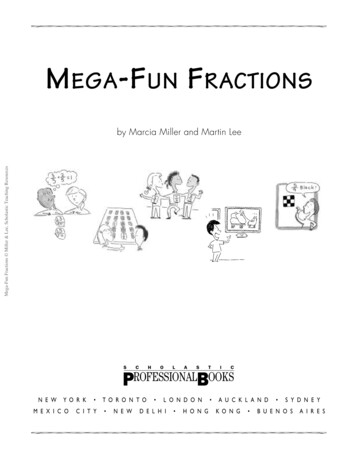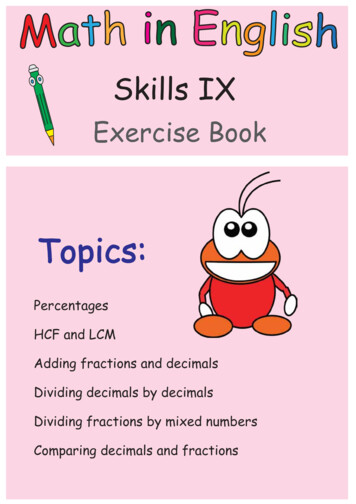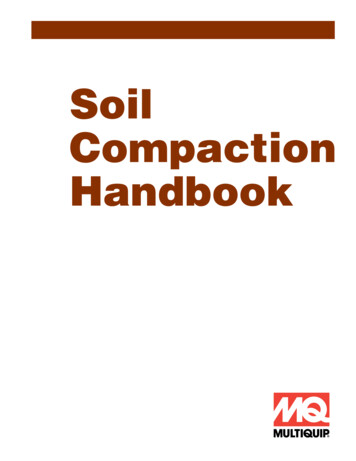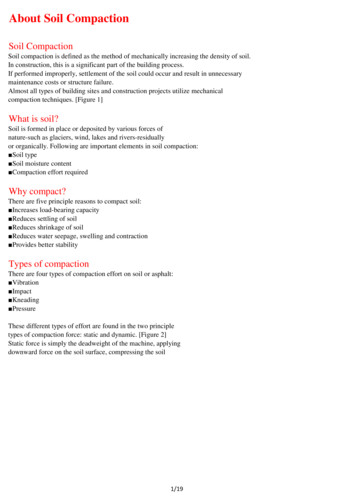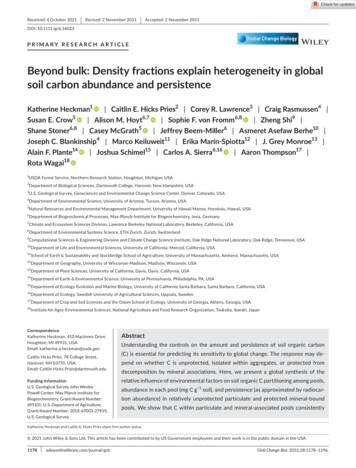
Transcription
Received: 4 October 2021 Revised: 2 November 2021 Accepted: 2 November 2021DOI: 10.1111/gcb.16023PRIMARY RESEARCH ARTICLEBeyond bulk: Density fractions explain heterogeneity in globalsoil carbon abundance and persistenceKatherine Heckman1 Caitlin E. Hicks Pries2 Corey R. Lawrence3 Craig Rasmussen4 Susan E. Crow5 Alison M. Hoyt6,7 Sophie F. von Fromm6,8 Zheng Shi9 Shane Stoner6,8 Casey McGrath5 Jeffrey Beem- Miller6 Asmeret Asefaw Berhe10 Joseph C. Blankinship4 Marco Keiluweit11 Erika Marín- Spiotta12 J. Grey Monroe13 Alain F. Plante14 Joshua Schimel15 Carlos A. Sierra6,16 Aaron Thompson17 Rota Wagai181USDA Forest Service, Northern Research Station, Houghton, Michigan, USA2Department of Biological Sciences, Dartmouth College, Hanover, New Hampshire, USA3U.S. Geological Survey, Geosciences and Environmental Change Science Center, Denver, Colorado, USA4Department of Environmental Science, University of Arizona, Tucson, Arizona, USA5Natural Resources and Environmental Management Department, University of Hawaii Manoa, Honolulu, Hawaii, USA6Department of Biogeochemical Processes, Max- Planck- Institute for Biogeochemistry, Jena, Germany7Climate and Ecosystem Sciences Division, Lawrence Berkeley National Laboratory, Berkeley, California, USA8Department of Environmental Systems Science, ETH Zurich, Zurich, Switzerland9Computational Sciences & Engineering Division and Climate Change Science Institute, Oak Ridge National Laboratory, Oak Ridge, Tennessee, USA10Department of Life and Environmental Sciences, University of California, Merced, California, USA11School of Earth & Sustainability and Stockbridge School of Agriculture, University of Massachusetts, Amherst, Massachusetts, USA12Department of Geography, University of Wisconsin- Madison, Madison, Wisconsin, USA13Department of Plant Sciences, University of California, Davis, Davis, California, USA14Department of Earth & Environmental Science, University of Pennsylvania, Philadelphia, PA, USA15Department of Ecology Evolution and Marine Biology, University of California Santa Barbara, Santa Barbara, California, USA16Department of Ecology, Swedish University of Agricultural Sciences, Uppsala, Sweden17Department of Crop and Soil Sciences and the Odum School of Ecology, University of Georgia, Athens, Georgia, USA18Institute for Agro- Environmental Sciences, National Agriculture and Food Research Organization, Tsukuba, Ibaraki, JapanCorrespondenceKatherine Heckman, 410 MacInnes Drive,Houghton, MI 49931, USA.Email: katherine.a.heckman@usda.govCaitlin Hicks Pries, 78 College Street,Hanover, NH 03755, USA.Email: Caitlin.Hicks.Pries@dartmouth.eduFunding informationU.S. Geological Survey John WesleyPowell Center; Max Planck Institute forBiogeochemistry, Grant/Award Number:695101; U.S. Department of Agriculture,Grant/Award Number: 2018- 67003- 27935;U.S. Geological SurveyAbstractUnderstanding the controls on the amount and persistence of soil organic carbon(C) is essential for predicting its sensitivity to global change. The response may depend on whether C is unprotected, isolated within aggregates, or protected fromdecomposition by mineral associations. Here, we present a global synthesis of therelative influence of environmental factors on soil organic C partitioning among pools,abundance in each pool (mg C g 1 soil), and persistence (as approximated by radiocarbon abundance) in relatively unprotected particulate and protected mineral- boundpools. We show that C within particulate and mineral- associated pools consistentlyKatherine Heckman and Caitlin E. Hicks Pries share first author status. 2021 John Wiley & Sons Ltd. This article has been contributed to by US Government employees and their work is in the public domain in the USA1178 wileyonlinelibrary.com/journal/gcbGlob Change Biol. 2022;28:1178–1196.
HECKMAN et al.1179differed from one another in degree of persistence and relationship to environmentalfactors. Soil depth was the best predictor of C abundance and persistence, thoughit accounted for more variance in persistence. Persistence of all C pools decreasedwith increasing mean annual temperature (MAT) throughout the soil profile, whereaspersistence increased with increasing wetness index (MAP/PET) in subsurface soils(30– 176 cm). The relationship of C abundance (mg C g 1 soil) to climate varied amongpools and with depth. Mineral- associated C in surface soils ( 30 cm) increased morestrongly with increasing wetness index than the free particulate C, but both poolsshowed attenuated responses to the wetness index at depth. Overall, these relationships suggest a strong influence of climate on soil C properties, and a potential loss ofsoil C from protected pools in areas with decreasing wetness. Relative persistence andabundance of C pools varied significantly among land cover types and soil parent material lithologies. This variability in each pool's relationship to environmental factorssuggests that not all soil organic C is equally vulnerable to global change. Therefore,projections of future soil organic C based on patterns and responses of bulk soil organic C may be misleading.KEYWORDSclimate change, persistence, radiocarbon, soil carbon, soil fractions, soil organic matter,terrestrial carbon cycle1 I NTRO D U C TI O Nmeasures of the influence of these soil forming factors on soil organic C abundance and persistence (Sierra et al., 2018) has beenInvestigations into the controls on soil organic carbon (C) have oftenhampered by the heterogeneous nature of soil organic C and thetreated it as a single homogeneous pool (e.g., Rasmussen et al., 2018;complexity of the interactions among soil forming factors.Shi et al., 2020). However, decades of research have emphasizedSoil organic C decomposition rates comprise a spectrum rang-the heterogeneity of soil organic C (Ågren & Bosatta, 1996; Hénining from hours to millennia. Likewise, the molecular composition of& Dupuis, 1945; Swift et al., 1979; Trumbore, 2009). Soils have asoil organic C varies widely based on source, degree of decomposi-range of C pools cycling at different timescales, making estimatestion, and association with soil minerals and within soil aggregates.14of soil organic C persistence based on bulk Δ C values misleadingAlthough there are approaches to model the continuum of decom-(Gaudinski et al., 2000; Trumbore & Zheng, 1996). Improving how weposition rates of soil organic C (Ågren & Bosatta, 1996; Carpenter,parameterize terrestrial C models to better predict global C dynam-1981), models often partition this continuum of rates into a fewics requires building a better understanding of the environmentaldiscrete categories or pools (Elliott et al., 1996; Sierra et al., 2012).factors that control the size and distribution of these active and pas-Pools that exhibit true mechanistic differences may not be physi-sive C pools (Blankinship et al., 2018; Davidson & Janssens, 2006).cally measurable. However, the wide variation in the criteria used toUnderstanding the relationship between the physical environmentevaluate these pools (e.g., radiocarbon, incubation, fractionation) isand the partitioning of C among these pools will also be important ifoften used as evidence that bulk soil contains multiple pools that ex-we are to develop strategies to improve soil health and estimate thehibit distinct dynamics (Baisden & Canessa, 2013; Buchkowski et al.,potential for C sequestration to mitigate climate change (Bongiorno2019; Cotrufo et al., 2013). As there is increasing evidence that ra-et al., 2019).diocarbon data can be used to constrain global soil C models (e.g., HeTherefore, to better understand the response of soil organic Cet al., 2016a), it is essential that we test whether our measurementsto global change, it is important to go “beyond bulk C” and considerof these pools align with their conceptual representation in our mod-whether distinct functional C pools are regulated by the same, sim-els (Blankinship et al., 2018).ilar, or unique soil forming factors on a global scale. At the broadestOur current conceptual understanding of soil organic C cyclingconceptual scale, the critical “soil forming factors” that regulate soildivides bulk organic C into pools directly associated with specificorganic C stabilization include climate (cl), organisms (o), and relief (r)mechanisms and processes that affect its decomposition rate,modifying soil parent material (p) through inputs and weathering re- including mineral sorption, aggregation, and microbial accessibility.actions over time (t; referred to as the “cl,o,r,p,t” soil forming factors;In practice, laboratory studies separate bulk soil organic C into oper-Dokuchaev, 1883; Jenny, 1941). However, assigning quantitativeationally defined fractions that differ based on physical, biological, or
1180 HECKMAN et al.chemical properties and are associated with specific mechanisms ofrate. Though many models are structured with multiple soil organicstabilization (Baisden et al., 2002; Golchin et al., 1994; Jastrow et al.,C pools, global- scale models are often validated with bulk soil C data1996; Six et al., 2000; Swanston et al., 2005; Trumbore & Zheng,(e.g., from the Harmonized World Soils Database). Research has con-1996). For example, density fractionation isolates soil organic C intocluded that the mean age of bulk soil C is hundreds to thousandsfree particulate, occluded particulate, and mineral- associated frac-of years (He et al., 2016b; Shi et al., 2020; Sierra et al., 2018). Fromtions (Figure S1; Greenland, 1964; Heckman et al., 2014; Lavalleea climate change perspective, the potential of soils to sequesteret al., 2020; Sollins et al., 1999; Spycher et al., 1983) that are hy-CO2 may therefore be limited by the slow assimilation rates of newpothesized to align with current conceptual pools associated withinputs or the development of new reactive secondary mineral phasesdifferent stabilization mechanisms (Cotrufo et al., 2019).(Schlesinger, 1990). To determine soil C dynamics on the timescaleIn this study, we use a global synthesis of soil radiocarbonof anthropogenic climate change, information about the full spec-data (Beem- Miller et al., 2021; Lawrence et al., 2020) to evaluatetrum of soil C pools and their associated decomposition rates wouldwhether the three common fractions isolated through density frac-be beneficial. In particular, soil organic C dynamics under climatetionation methods (Figure S1; Golchin et al., 1994) exhibit distinctchange are likely determined by the active and intermediate (e.g.,relationships with soil forming factors at the global scale. The freeparticulate) pools which may be more responsive to changes in in-particulate fraction (also known as the free light fraction) includesputs (Crow & Sierra, 2018; Knorr et al., 2005; Shi et al., 2020; Soongparticulate organics and any material not bound to minerals or oc-et al., 2021). Better understanding of these intermediate pools couldcluded in aggregates; this fraction floats in a dense liquid (mostimprove our ability to manage both C inputs and C persistence tocommonly sodium polytungstate). Conceptually, this fraction is themaximize the climate benefit of C sequestration (Crow & Sierra,most microbially available and the least persistent of the fractions2018; Sanderman et al., 2017; Sierra et al., 2021; Van Gestel et al.,(excepting dissolved C, which is not captured in traditional density2018). Furthermore, we could develop more effective pathways tofractionation methods), corresponding to an actively metabolized orsequester C by identifying management practices that encouragefast- cycling pool in models. The particulate occluded fraction (alsogreater C stabilization and slower rates of soil organic mineraliza-known as the occluded light fraction)— composed of particulate or-tion. However, prior to identifying these management techniques,ganic matter released after vigorous mixing and ultrasonic disrup-it is essential to establish a firm understanding of what controls thetion of soil aggregates— is assumed to be physically protected frompartitioning of soil organic C into pools and governs C persistencemicrobial access through occlusion in aggregates. However, thewithin those pools.makeup of these aggregates is often heterogeneous (Marín- SpiottaHere, we assess the relationship of soil forming factors to theet al., 2008) and may include organic C with high molecular stabil-partitioning and persistence of soil organic C fractions in free par-ity such as pyrogenic C, phytoliths, and fungal spores (Wagai et al.,ticulate, occluded particulate, and mineral- associated fractions.2009). Conceptually, the particulate occluded fraction may be pro-We hypothesize that fractions respond differently to climate, veg-tected by physical isolation or molecular recalcitrance (as defined byetation, and physicochemical parameters due to differences in howstructural resistance to enzymatic attack or poor microbial substratethey are formed and protected from soil microbes. For example, wequality) and is commonly thought to cycle at intermediate rates hypothesize that the unprotected free particulate fraction should(Golchin et al., 1994; Wagai et al., 2009). After isolation of these twodecrease in response to increasing mean annual temperature andparticulate fractions, organic matter remaining is associated with thethe associated increase in microbial activity; in contrast, we hypoth-mineral fraction (sometimes referred to as the dense or heavy frac-esize that the more protected occluded and mineral- associated frac-tion) and is assumed to be adsorbed to, co- precipitated with, or re-tions should have no relationship to temperature because microbialside in microaggregate structures with minerals (Wagai et al., 2020).access, not activity, limits their decomposition. The relationships ofWe refer to this fraction as mineral- associated C. Conceptually,the fractions with soil forming factors can offer insights into the sen-mineral- associated C is the pool most protected from microbialsitivity of soil C to global changes.decomposition, corresponding to a more slowly cycling C pool. Incertain soils and ecosystems, the characteristics of these fractionshave been successfully linked to specific stabilization mechanisms2 M E TH O D S(von Lützow et al., 2007). However, the global applicability of thesefractions to conceptual C pools and the influence of environmentalWe used soil density fraction data from The International Soilfactors on these soil organic C fractions are poorly resolved.Radiocarbon Database (ISRaD v. 1.1.2 Lawrence et al., 2020; www.The response of soil organic C to our changing climate is un-soilr adioc arbon.org). ISRaD is an online repository for environmen-certain in Earth system models (Shi et al., 2018; Todd- Brown et al.,tal radiocarbon data with a specific emphasis on soils and soil frac-2018); as a result, modelers place low confidence on soil organic Ctions. We utilized a subset of ISRaD data comprising measurementsresponse projections (Bradford et al., 2016; Davidson & Janssens,of radiocarbon (persistence), organic C concentration (abundance),2006; Friedlingstein et al., 2014). One source of uncertainty in mod-or the proportion of organic C in the mineral- associated fractioneling soil organic C dynamics is the complete lack of— or otherwise(distribution) made on soil density fractions for the current analysis.inconsistent treatment of— within- soil variance in decompositionRadiocarbon data are reported in units of Δ14C (‰) normalized to
HECKMAN et al.1181account for the year of sampling (Shi et al., 2020; see below). In stud-model and the observed time series of atmospheric Δ14C accord-ies that employed sequential density separation (isolation of multipleing to Shi et al. (2020). Steady state conditions assume constantfree light, occluded light, and heavy fractions for the same sample),inputs through time; therefore, input does not affect the resultthe multiple fractions were combined by taking a mass- weightedof normalization. Past atmospheric Δ14C records were obtained14average for C abundance and C- weighted average for Δ C values.from the Intcal13 calibration curve (50 kyr – 0 BP; Reimer et al.,C distribution among density fractions was normalized to sum to2013). Modern data from 1950 were obtained from Vermunt and100%. Overall, our meta- analysis included data from 52 studies. InSchauinsland stations (Levin & Kromer, 1997) extended throughaddition to C measurements, ISRaD compiles ancillary data regard-2012 (Hua et al., 2013; Levin et al., 2013). To normalize Δ14C froming site and sample characteristics that were either provided directlythe year of sampling to year 2000, we first constructed the relation-in the associated published works or provided as supplementaryship between turnover time and Δ14C to derive a turnover time foreach Δ14C value. Then we adjusted the original Δ14C value by run- information from manuscript authors.First, we compared the general characteristics of the threening the one- pool model with the respective turnover time to yeardensity fractions using a linear mixed model (LMM) with fraction2000. When Δ14C is greater than about 85‰, the calculation gener-as a fixed effect and the sampled layer nested in the study as aates two mean turnover times; the longer turnover times were used.random effect because fractions measured within a soil sample arenot independent nor are samples measured within the same study.We then used the emmeans (Lenth, 2019) package to perform post2.1 Explanatory variableshoc pairwise Tukey tests of differences between the fractions.Second, we used LMMs to explore how soil fractions interact withThe explanatory environmental variables used in the meta- analysisenvironmental predictors related to soil forming factors to affectwere grouped according to the soil forming factors (Jenny, 1941):C abundance, persistence, and distribution at a global scale (Figureclimate, organisms, relief, and parent material. The specific variablesS2). We chose the LMM approach so that we could explicitly in-included mean annual temperature (MAT), wetness index (MAP/clude interactions among the soil fractions and environmentalPET), net primary productivity (NPP), land cover type, elevation,predictors.slope, northness, and parent material (Table 1). The influence ofFor the radiocarbon data from the ISRaD, each Δ14C measure-time on the degree of soil morphological development was not ex-ment was normalized to the year 2000 using a steady state one- poolplicitly included in this analysis due to the difficulty of determiningTA B L E 1 The source of the environmental predictors representing CLORPT soil forming factors used in our analysesCLORPT factorModel predictorUnitClimateMean annualtemperature (MAT) CWetness indexRatio, mm mm 1SourceResolutionWorldClim 2.11 kmMean annual )WorldClim 2.1 (MAP),Global AridityIndex and PotentialEvapotranspirationClimate Database v2(PET)1 km (MAP), 30arc- seconds(PET)Net primaryproductivitykg C m 2Mean of values from2001– 2016MODIS/Terra500 mLand coverFactorReported in study, gap- filled with MODIS/Terra Aqua500 mElevationmDEM (World ElevationTerrain): Esri LivingAtlas30 mSlope%DEM (World ElevationTerrain): Esri LivingAtlas30 mNorthness 1 (equator- facing) to1 (pole- facing)DEM (World ElevationTerrain): Esri LivingAtlas30 mParent MaterialParent aspect)*sin(slope),adjusted so 1 isequator facingReported in study, expertopinion
1182 HECKMAN et al.approximate soil ages. Along with the soil forming factors described14multicollinearity that can occur with interaction terms. However,above, we included fraction (for Δ C and C abundance models only)we graphically present the predicted relationships between our re-and depth as predictors. Depth referred to the middle of each incre-sponse variables and soil forming factors using unscaled and uncen-ment sampled to integrate across the various sampling approachestred explanatory variables and untransformed response variables toused. The top of the mineral soil was set to 0 cm following soil sci-better illustrate their actual effects. The predicted lines were cal-ence convention. When directly reported information on theseculated based on the LMM using the “ggpredict” function from thevariables was available in ISRaD, it was used. When variables ofggeffects package (Lüdecke, 2018) and represent the relationshipinterest were not available directly through ISRaD, these variablesbetween the response variable and a continuous predictor of inter-were populated through utilization of geolocated databases (Table 1;est with other continuous predictors set to their means and the landSupporting Information).cover and parent material factors set to temperate forest and igne-As is the nature of meta- analyses, our dataset is limited by theous intrusive, respectively.availability of soil fraction data that include radiocarbon valuesWe chose which interactions to include in our model based on(Figures S2). We evaluated the distribution of MAT, wetness index,a priori hypotheses and graphical exploration. Based on a prioriNPP, slope, and elevation in our dataset against their respectivehypotheses, we included two- way interactions between wetnessglobal distributions (Figure S3). The dataset represents the globalindex slope (due to the dependence of infiltration and erosiondistribution of these variables well except for flat regions (note thaton slope), wetness index parent material (due to the differentialvery cold regions are mostly from Antarctica and circumpolar re-weathering rates of different lithologies), fraction parent mate-gions which likely do not have soil, Figure S3g). However, the datasetrial (because we expect lithology to have a stronger effect on theis skewed toward the northern hemisphere and temperate forests,mineral- associated fraction), and two- and three- way interactionswhere the majority of soil density fractionation studies have beenamong MAT fraction depth (because we expect temperaturecarried out (Figures S2– S 4). The full compiled dataset used in thesensitivity may differ among soil fractions and depths) and wetnesscurrent analysis is available in the supplementary materials. For a de-index fraction depth (moisture influences transport of organicstailed description of explanatory variable extraction/origin, pleaseand mineral phases with depth in the profile). Based on graphicalsee supplementary materials.exploration of the relationships of response variables to soil formingpredictors by fraction (e.g., Figures S8 and S12), we also included the2.2 Linear mixed- effects modelstwo- way interactions of fraction land cover and fraction slope.To optimize the random effect structure, we ran our full model(all predictors and the interactions described above) for Δ14C, the re-We ran mixed model multiple regressions using the lmer commandsponse variable for which we had the most data (n 1323) using thefrom lme4 (Bates et al., 2014) in R v. 3.5.3 3 (R Core Team, 2020) tolmer command (lme4 package) in R (R Core Team, 2020). The randomdetermine the relationships between soil forming factors, depth, andeffects tested included a random slope of the depth effect basedsoil fraction, and the three response variables: normalized Δ14C val-on the soil pedon, random intercepts based on the study (entryues (‰), the abundance of organic C in each fraction (in mg C per gname in ISRaD), the soil pedon nested within study, the soil layersoil), and the proportion of organic C stored in the heavy fraction. Wenested within study, and the soil layer nested within the soil pedon.report the results of the final models with p- values calculated usingCombinations of these random effects were compared using AICthe lmerTest package (Kuznetsova et al., 2016) and the marginal andand the model with the lowest AIC was chosen. The best- fit modelconditional R 2 values computed using the “r.squaredGLMM” func-had a random slope of the depth effect based on the soil pedon andtion from the MuMIN package (Bartoń, 2019). We report F- test sta-random intercepts of the soil layer nested within the study. Thus,tistics as a relative measure of the amount of variance explained bythe model accounted for the relationship between Δ14C and deptheach fixed effect while taking into account the degrees of freedom.varying by the soil core or pit, the fact that the fractions sampledWhere possible (e.g., where interactions were not missing certainwere not independent (they were derived from the same soil layer),combinations), we further explored statistically significant interac-and the lack of independence among soil layers from the same study.tions using post hoc tests of the estimated marginal means usingNext, we ran the full model with the optimum random effectsthe emmeans package (Lenth, 2019). We present the results fromand graphed residuals versus all the predictors to test whethermodels for which we optimized the random effects structure usingthe assumption of variance homogeneity was violated, which itAkaike's information criterion (AIC) and tested for violations of ho-was because variance increased with soil depth. The lmer func-mogeneity of variance and linearity assumptions. We limited ourtion does not have an argument to handle variance heterogene-analyses to data from soil depths 300 cm because below that depthity. Thus, in consultation with a developer of lme4 (Dr. Benjaminthe relationships between our response variables and depth becameBolker, McMaster University, written communication, March 3,nonlinear. We checked for multicollinearity among our continuous2020), we chose to account for variance homogeneity by creatingpredictors and did not include any pairs of predictors that had a cor-an observation level random effect that interacts with a dummyrelation value (r) 0.6 (Dormann et al., 2013; Figure S5). We usedvalue for quantiles of depth (2.5– 5.5 cm, 5.5– 10 cm, 10– 19 cm, 19– centered and scaled continuous variables in the model to reduce the37.5 cm, 37.5– 67.5 cm, and 67.5– 176 cm) excluding the shallowest
HECKMAN et al.depth quantile, which had the lowest variance. Graphing residuals1183(1.2 0.2‰), while the mineral- associated fraction was the mostdemonstrated that this approach reduced variance heterogeneity.enriched ( 23.8 0.2‰ and 4.4 0.2‰; p .0001 for both).Lastly, we graphed partial residuals to ensure that the relationshipsLastly, the free particulate fraction had significantly youngerbetween our response variables and continuous predictors wereΔ14 C values (6.2 7.5) than the occluded particulate or mineral- linear. Satisfied that the assumptions of linear models were met,associated fractions (p .0001), whose Δ14 C (‰) did not differwe proceeded to the final full model, which included all explan-significantly from one another ( 50.9 12.6 and 79.4 8.0, re-atory variables, the chosen interaction terms, the random effectspectively; p .58).structure with the smallest AIC, and the dummy values to accountOverall, our LMMs using soil forming factors, depth, and fraction as predictors explained over half the variation in Δ14C (‰)for depth heterogeneity.We followed the same procedure for the C abundance in theand C abundance (mg C g 1 soil; marginal R 2 0.60 and 0.59, re-various fractions (n 981) and used the same random effects struc-spectively; Figures 2 and 3). Depth and fraction type explainedture as the Δ14C model. The C abundance model did not need athe largest amount of variation in both models according to theirvariance structure, but the responses were log transformed to meetF values, though depth had a much higher explanatory power forthe assumption of linearity. The proportion of C in the heavy frac-Δ14C. However, our LMM using soil forming factors and depth astion model (n 457) also did not need a variance structure, but thepredictors explained less than half the variation in the proportionresponses were logit transformed and the depth predictor was logof C associated with the heavy fraction (marginal R 2 0.40; Figuretransformed to meet assumptions of linearity.S6). The relative significance of soil forming factors varied slightlyamong models depending on the response variable. Detailed results3 for each model are given below.R E S U LT SWe found consistent and significant differences in density frac-3.1 C persistence (normalized Δ14C)tion characteristics at the global scale (Table 2; Figure 1). On average, mineral- associated fractions had the lowest C concentrationsDepth explained the largest amount of variation in our Δ14C model(2.3 0.2%) but had the greatest C abundance (17.4 1.2 mg(F 368; p .001). As expected, soil fraction was a significant predic-g 1soil) due to their high mass compared to free and occludedparticulate fractions (p .0001). Soils stored almost 60% of theirtor in our Δ14C model (F 25, p .001) and significantly interactedwith depth (fraction depth, F 8, p .0004, Figure 4). Carbonorganic C in mineral fractions, whereas only 14% was stored inpersistence increased with depth as Δ14C became more depleted,occluded fractions (p .0001). Occluded particulate fractionsand this effect of depth was stronger in the occluded particulatehad the highest C:N (32 0.2) while mineral- associated fractionsand mineral- associated fractions than in the free particulate fractionhad the lowest C:N (13 1; p .0001). The free particulate frac-(Figure 4). Though soil forming factors explained smaller portionstion was similar to occluded fraction in δ13C ( 25.2 0.2‰ vs.of variance, several significant relationships with climate variables 25.5 0.2‰) but was the most depleted (smaller values) in δ15Nwere noted. Contrary to our hypothesis, C persistence decreasedTA B L E 2 General characteristics of den
abundance of C pools varied significantly among land cover types and soil parent ma-terial lithologies. This variability in each pool's relationship to environmental factors suggests that not all soil organic C is equally vulnerable to global change. Therefore, projections of future soil o
